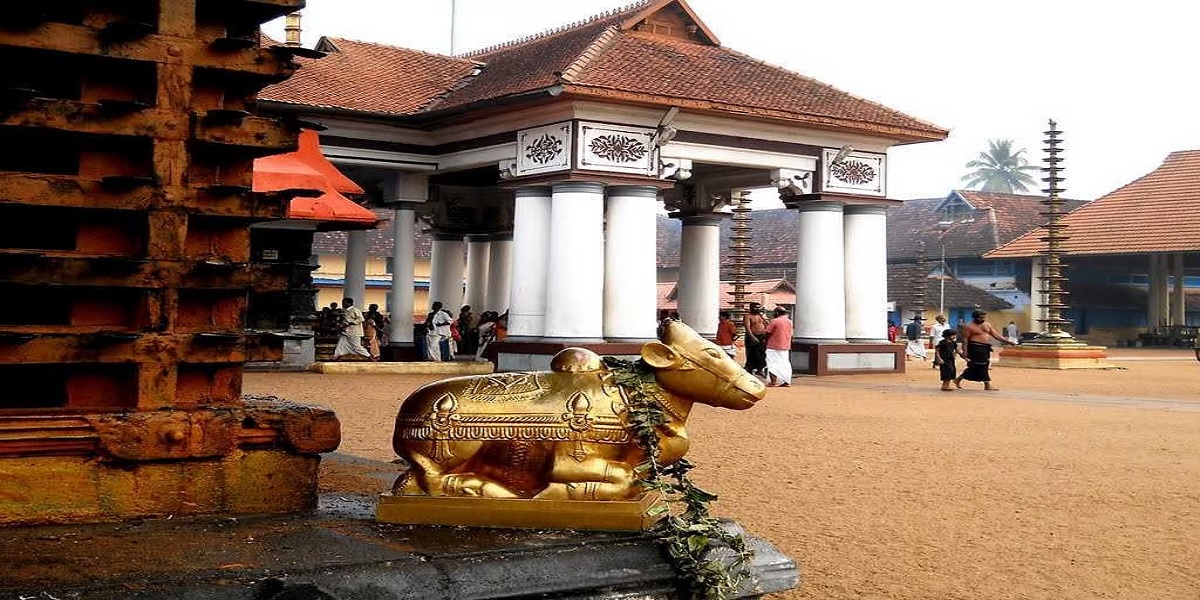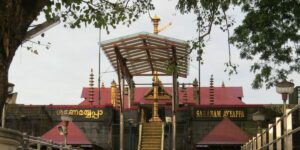Even under a strong Constitution that guarantees equal rights, the privileged caste oligarchy continues to thrive.
Published Mar 13, 2025 | 9:00 AM ⚊ Updated Mar 16, 2025 | 6:07 PM

Vaikom Mahadeva Temple.
Synopsis: Recently, the Koodalmanikyam Temple in Irinjalakuda of the Thrissur district became the center of a caste controversy, exposing the deep fault lines within the state’s religious institutions. South First investigation has uncovered widespread caste barriers across Kerala’s temples, from the renowned Sabarimala to the historically relevant Vaikom Mahadeva Temple.
Even while Kerala is celebrating the centenary of the Vaikom Satyagraha, caste still draws the line between devotion and exclusion in the temples in the state. Recently, the Koodalmanikyam Temple in Irinjalakuda of the Thrissur district became the center of a caste controversy, exposing the deep fault lines within the state’s religious institutions.
On 24 February, BA Balu, an Ezhava community member, was appointed the second Kazhakam through the Kerala Devaswom Recruitment Board. However, the temple’s tantris (priests) refused to accept the appointment, boycotting ceremonies in protest.
As the backlash intensified, Devaswoms Minister VN Vasavan denounced the caste-based discrimination, calling it “shameful for Kerala society.”
He told South First that under Clause 4 of the 2003 regulation, Kazhakam posts are filled in two ways, those with a salary of ₹1025 and dearness allowance (DA) based on the Tantri’s (priest) recommendation and higher salary posts through the Kerala Devaswom Recruitment Board.
Balu was appointed to the second Kazhakam post via the Board, but the Tantris opposed it.
The minister noted that it was unfortunate in a land where even non-Brahmins have served as priests. Kazhakkarans are appointed to the Kazhakam post to prepare garlands and other pooja supplies and perform external chores at the temple.
The Kerala State Human Rights Commission (SHRC) has launched an investigation, and the matter has now escalated into a legal battle. A crucial meeting is set for tomorrow to decide Balu’s role in the temple. However, he has already made his position clear, he no longer wants the Kazhakam job and prefers an office role instead.
Meanwhile, South First investigation has uncovered widespread caste barriers across Kerala’s temples, from the renowned Sabarimala to the historically relevant Vaikom Mahadeva Temple.
The obsession with oligarchy among political parties, the government, and even the courts continues to make life miserable for priests belonging to the Scheduled Caste (SC), Scheduled Tribe (ST), and Other Backward Class (OBC) communities. They still endure blatant caste discrimination that reflects the dark past of the state.
Even while the whole state was discussing the alleged caste discrimination at the Koodalmanikyam Temple, Bharatanatyam dancer Mansiya VP remained unfazed, engrossed in teaching dance to children.
Having faced similar discrimination before, the controversy did not surprise her.
In 2022, Mansiya was barred from performing at the Koodalmanikyam Temple for being a non-Hindu. The temple, under the state-controlled Devaswom Board, denied her permission for the festival performance.
In response, the CPI(M)’s youth wing — the Democratic Youth Federation of India (DYFI) — arranged a “Secular Stage” for her at Irinjalakuda Town Hall, just two kilometres from the temple.
This wasn’t her first experience of religious discrimination, earlier, Islamic clerics had boycotted her for pursuing classical dance despite being born Muslim.
When South First reached out to Mansiya, she responded, “I wasn’t shocked to hear this. The dominance of the privileged class is very evident in Koodalmanikyam Temple.”
However, Balu’s voice remains much weaker compared to Mansiya’s. Even though fearful of further consequences, he still stands by his decision, not to continue as Kazhakam staff but to seek a position in the temple’s office.
“There are many other OBC Kazhakam staff members in the temple. I previously worked at a Travancore Devaswom Board temple as a contract staff member. Later, in 2023, I took the Devaswom Board exam because I needed a permanent job. That dream became a reality, but I never expected to face this fate within days of joining. A meeting is scheduled for 12 March, and I hope things will be resolved,” he told South First.
A dancer from Thrissur, who belongs to the OBC community, told South First, “Before performing at Koodalmanikyam Temple, we are required to fill out a form disclosing our religious details. Once, they openly asked me about my caste to decide how to treat me.”
It’s not just artists and staff members who face such discrimination, even the Kerala Police has encountered caste bias at the temple. A police officer from Thrissur told South First, “For the first time in my career, someone asked me about my caste while I was on duty. It’s as if they are still living centuries ago, unaware that democracy exists.”
When South First contacted Sree Narayana Dharma Paripalana (SNDP) Yogam General Secretary Vellappally Natesan, he stated, “Hindu unity would be meaningless without addressing caste-based inequalities. Those who try to uphold the caste system only undermine it. Hindu unity holds no relevance as long as such incidents continue.”
However, historian and scholar Dr TS Syam Kumar, who specialises in Hindutva, casteism and Brahmanism, raised pressing questions. “Why didn’t the SNDP organise a march to this temple? Where is the DYFI? Beyond mere promises and statements from the Devaswoms minister, why hasn’t any action been taken against the Tantris? Do you think such practices exist only in Koodalmanikyam Temple?”

Sabarimala Temple. (Wikimedia)
In 2021, Vishnu Narayanan, an experienced priest from the Ezhava community, moved the Kerala High Court asserting his fundamental right after being denied the Melshanthi (head priest) post at Sabarimala solely for not being a Malayala Brahmin.
Despite a 2002 Supreme Court ruling in the N Adithayan vs Travancore Devaswom Board (TDB) case that priesthood cannot be restricted to Brahmins, Sabarimala temple insists on this criterion.
Vishnu, with 16 years of experience as Melshanthi at Pallom Subramania Swamy temple, met all requirements — experience, Sanskrit proficiency, and formal training.
His 2017 application was rejected without reason, in 2018, TDB explicitly stated “Rejected for not being a Malayala Brahmin,” prompting his legal challenge.
The case questions caste-based exclusion in one of Kerala’s most significant temples, even as TDB appointed 39 Dalit and OBC priests after reservation norms were introduced in 2017.
Syam Kumar told South First that the Akhila Kerala Tantri Samajam, a fraternity of Brahmins, had filed a writ petition against Vishnu. The Kerala High Court rejected Vishnu’s petition, and he is now fighting in the Supreme Court for his fundamental rights.
According to the manual of the Akhila Kerala Tantri Samajam, membership is restricted to those whose ancestors have held the tantri position for at least seven generations. This effectively means that only those born into the Brahmin caste can become members. This case reflects how caste operates in Kerala.
The push for inclusivity in Kerala’s temple priesthood has its roots in an initiative led by RSS ideologue P Madhavan. Grounded in the philosophy that every individual is born a ‘Shudra‘ and ascends to higher spiritual roles through their karma, Madhavan championed the idea that priesthood should be based on merit rather than birth.
His efforts culminated in a historic event, the Paliyam Proclamation of 1986, made at the Chendamangalam Palace. The gathering included Azhvancherry Thamprakkal, the seniormost member of the influential Azhvancheri mana, along with other prominent Brahmin figures. After extensive discussions, they were convinced to support the induction of non-Brahmin priests in Hindu temples.
To implement this reform, Madhavan organised a 10-day study camp (Patana Shibiram), where 25 non-Brahmins underwent rigorous training in temple rituals and tantric practices. The sessions were led by Azhakathu Sasthrasharman Namboodirippad, an experienced priest who played a crucial role in equipping the trainees with the necessary religious knowledge and skills.
Despite this progressive shift, caste-based discrimination continues. An incident at the Chettikulangara Devi Temple in Alapuzha highlights lingering biases.
Sudhikumar, a non-Brahmin priest appointed as Keezhshanthi (junior priest), faced opposition from the temple’s Brahmin community and was prevented from carrying out his duties.
However, after the government intervened and reinstated him through an official order, he has now been allowed to function in his role.
When South First reached out to some Brahmin families in Thiruvananthapuram, they expressed concerns that allowing non-Brahmins into temples like Sabarimala could set a precedent, eventually leading to the appointment of SC and OBC priests in Kerala’s major temples like Guruvayoor and Sree Padmanabha Swamy temple.
They argued that the role of temple priests has traditionally been restricted to certain families, even within the Brahmin community, and believe that the custom must continue in its traditional form.
Dr Amal C Rajan, a researcher and activist, told South First that though Brahmanical dominance is witnessing a resurgence, history provides counterexamples of reform.
“In 1910, the Cochin District Magistrate, influenced by Brahmanical interests, imposed a ban preventing untouchables from using roads around the Koodalmanikyam Temple. This discriminatory order remained in place until 1946, when the Kuttamkulam agitation successfully overturned it, ensuring access for all castes,” he said.
“The temple has also been a site of labour unrest. In 1969, over 40 employees were abruptly dismissed without justification. Although the high court ruled in their favour, temple authorities refused to reinstate them, arguing they were under no obligation to comply,” he added.
“Another striking instance is Umayamma Rani’s decision to remove the Tharanalloor family from the Sree Padmanabhaswamy Temple’s Tantri post, ending their centuries-old hold. The Mathilakam Records document the Rani’s assertion, the Tantri is neither the deity’s father nor mother but merely an appointed staff,” Amal noted.
According to Syam Kumar, Kerala’s so-called caste balancing needs to be critically examined.
He noted that despite claims of inclusivity, Brahmins still prefer only Ambalavasis (temple-dwelling people), comprising castes like Pisharody, Varrier, Pushpakas, and Elayidom (a Nair subcaste), etc, to be a Kazhakam.
Even Vaikom Temple, which witnessed one of the greatest anti-caste revolutions in Indian history and is celebrated by both Kerala and Tamil Nadu, has yet to appoint a non-Brahmin priest.
While Dalits and other backward castes are technically allowed to work in temples and perform poojas in certain places, major revenue-generating temples remain dominated by Brahmins. Non-Brahmin priests are primarily appointed in less significant temples, while prominent temples like Chettikulangara, Chottanikkara, and Poornathrayeesa continue to uphold Brahminical supremacy.
Kerala wears a thin veil of progressiveness, but casteist practices remain deeply rooted. Even under a strong Constitution that guarantees equal rights, the privileged caste oligarchy continues to thrive.
(Edited by Muhammed Fazil.)
